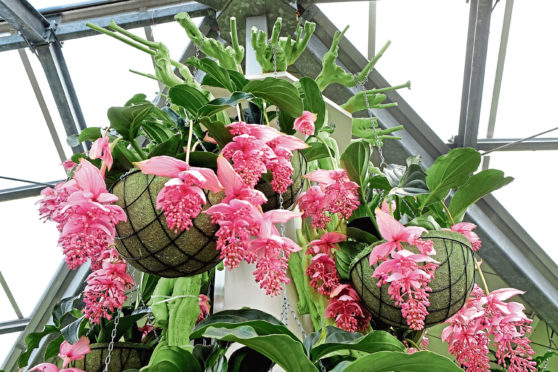
Look closely at Skimmia japonica Rubella and you’ll see that the brick-red buds are starting to appear. These will remain tightly-wrapped for months before opening into scented white flowers, making them a wonderful addition to the garden throughout autumn and winter.
If you’ve watched the Netflix adaptation of the classic novel, Rebecca, then you’ll know that the star of this tale of intrigue and dark deeds in Cornwall in the 1930s is not the starry cast nor even the great house that sits at the centre of the action, but the vast collection of houseplants that appear in almost every shot.
From brass urns filled with lush ferns to garden rooms wreathed in tender climbers, there’s almost more greenery indoors than there is in the impressive gardens. Amongst the foliage there are many flowering houseplants, the most impressive being the wonderful Medinilla magnifica, which spills its long racemes of flowers like pink jewels from an ostentatious candelabra.
I first came across this extraordinary plant in a fancy flower shop and then found it again growing in the glasshouses of Glasgow Botanic Gardens where there’s a specimen so large that it could fill an entire room. Yet despite its appearance, this Medinilla is easy to please. Just keep it somewhere bright and warm, mist it to prevent the foliage from becoming too dry and don’t let sunlight scorch the leaves.
Not everyone has space to accommodate such a show-stopper, but everyone can find a spot for the small but cheerful bead plant, (Nertera granadensis), which at the moment is covered in tiny orange berries, each one the size of a pinhead. Low-growing and rounded, like a small cushion, it’s an easy choice for a cool position, where it will be very undemanding. Feed it very occasionally while the berries are on the plant, water it less in winter than during the rest of the year and re-pot it in spring.
For more winter colour grow a bromeliad, choosing one with orange or scarlet bracts. This needs a warmer room than the bead plant and you’ll also need to fill the central rosette with water at regular intervals.
In tropical regions bromeliads can be found high up in the trees, where they grow by clinging to the branches and the little pools of water that they contain are used as homes by small aquatic creatures.
But you don’t need a rubber tree to perch it on, grow it in composted bark or any orchid compost and it will be very happy, even without a resident frog for company.

Enjoy the convenience of having The Sunday Post delivered as a digital ePaper straight to your smartphone, tablet or computer.
Subscribe for only £5.49 a month and enjoy all the benefits of the printed paper as a digital replica.
Subscribe